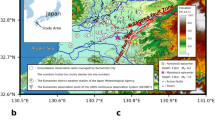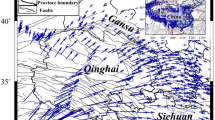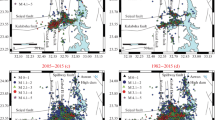Abstract
In 2006, we started construction of an observation network of 12 stations in and around Shikoku and the Kii Peninsula to conduct research for forecasting Tonankai and Nankai earthquakes. The purpose of the network is to clarify the mechanism of past preseismic groundwater changes and crustal deformation related to Tonankai and Nankai earthquakes. Construction of the network of 12 stations was completed in January 2009. Work on two stations, Hongu-Mikoshi (HGM) and Ichiura (ICU), was finished earlier and they began observations in 2007. These two stations detected strain changes caused by the slow-slip events on the plate boundary in June 2008, although related changes in groundwater levels were not clearly recognized.








Similar content being viewed by others
References
Ando, M. (1975), Source mechanisms and tectonic significance of historical earthquakes along the Nankai trough, Japan, Tectonophysics 27, 119–140.
Disaster Prevention Research Institute, Kyoto University (2003a), A fault model for the precursory slip that might have induced groundwater changes, Rep. Coord. Com. Earthq. Pred. 70, 402–403 (in Japanese).
Disaster Prevention Research Institute, Kyoto University (2003b), On the decrease of the well water prior to the Nankai earthquake — A mechanism of the amplification, Rep. Coord. Com. Earthq. Pred. 70, 423–428 (in Japanese).
Hirose, F., Nakajima, J., and Hasegawa, A. (2007), Three-dimensional velocity structure in Southwestern Japan and configuration of the Philippine sea slab estimated by double-difference tomography, J. Seismol. Soc. Jpn. 60, 1–20 (in Japanese).
Hydrographic Bureau, Report on the Nankai earthquake in 1946 (Change of the land surface and damage), (Hydrographic Bulletin, special number, 1948) (in Japanese).
Hori, T. (2006), Mechanisms of separation of rupture area and variation in time interval and size of great earthquakes along the Nankai Trough, southwest Japan, J. Earth Simulator 5, 8–19.
Itaba, S. and Koizumi, N. (2007), Earthquake-related changes in groundwater levels at the Dogo hot spring, Japan, Pure Appl. Geophys. 164, 2397–2410.
Linde, A.T. and Sacks, I.S. (2002), Slow earthquakes and great earthquakes along the Nankai trough, Earthq. and Planet. Sci. Lett. 203, 265–275.
Matsumoto, N., Kitagawa, Y., and Koizumi, N. (2007), Groundwater-level anomalies associated with a hypothetical perslip prior to the anticipated Tokai earthquake: Detectability using the groundwater observation network of the Geological Survey of Japan, AIST, Pure Appl. Geophys. 164, 2377–2396.
Mogi, K. (1982), Temporal variation of the precursory crustal deformation just prior to the 1944 Tonankai earthquake, J. Seismol. Soc. Jpn. 35, 145–148 (in Japanese).
Naito, H. and Yoshikawa, S. (1999), A program to assist crustal deformation analysis, J. Seismol. Soc. Jpn. 52, 101–103 (in Japanese).
Obara, K., Hirose, H., Yamamizu, F., and Kasahara, K. (2004), Episodic slow-slip events accompanied by non-volcanic tremors in southwest Japan subduction zone, Geophys. Res. Lett. 31, L23602, doi:10.1029/2004GL020848.
Obara, K. and Hirose, H. (2006), Non-volcanic deep low-frequency tremors accompanying slow slips in the southwest Japan subduction zone, Tectonophysics 417, 33–51.
Ohtani, R., Koizumi, N., Takahashi, M., Matsumoto, N., Sato, T., Kitagawa, Y., and Itaba, S. (2009), Appraisal of the detectivity of hypothetical preslip of the Tonankai and Nankai Great Earthquakes using the integrated groundwater observatories of the Geological Survey of Japan, AIST, Bull. Geol. Surv. Japan 60(11/12), 511–525 (in Japanese).
Okada, Y. (1992), Internal deformation due to shear and tensile faults in a half-space, Bull. Seismol. Soc. Am. 82, 1018–1040.
Rikitake, T. (1947), Groundwater changes at the Dogo hot spring related to the Nankai earthquake, Bull. Earthq. Res. Inst. 5,189–194 (in Japanese).
Roeloffs, E.A. (1996), Poroelastic techniques in the study of earthquake-related hydrologic phenomena, Adv. Geophys. 37, 135–195.
Sagiya, T. and Thatcher, W. (1999), Coseismic slip resolution along a plate boundary megathrust: The Nankai trough, southwest Japan, J. Geophys. Res. 104, 1111–1129.
Sangawa, A., Jishin-Kokogaku (Earthquake Archaeology), (Chuokoron-sha, 1992) (in Japanese).
Satake, K. (1993), Depth distribution of coseismic slip along the Nankai Trough, Japan, from joint inversion of geodetic and tsunami data, J. Geophys. Res. 98, 4553–4565.
Sato, T., Koizumi, N., and Nakabayashi, K. (2005), Did the groundwater flow stop in the Yunomine Spa associated with the 1946 Nankai earthquake?, Chishitsu News 609, 31–42 (in Japanese).
Shigetomi, K., Umeda, Y., Onoue, K., Asada, T., Hoso, Y., Kondo, K. and Takumi, T. (2005), Well water decrease and ocean tide abnormality before Nankai earthquake found out by the literature and hearing investigation, Annuals, Disaster Prevention Research Institute, Kyoto University 48B, 191–195 (in Japanese).
Tamura, Y., Sato, T., Ooe M. and Ishiguro, M. (1991), A procedure for tidal analysis with a Bayesian information criterion, Geophys. J. Int. 104, 507–516.
Usami, T., Materials for comprehensive list of destructive earthquakes in Japan, (416)-2001, (University Tokyo Press 2003) (in Japanese).
Acknowledgments
We wish to thank the members of the Tectono-Hydrology Team, Geological Survey of Japan, AIST for their cooperation and advice. We are grateful to the many people who have assisted us with our groundwater observations. We also wish to thank Dr. Townend and one anonymous reviewer for their helpful advice.
Author information
Authors and Affiliations
Corresponding author
Rights and permissions
About this article
Cite this article
Itaba, S., Koizumi, N., Matsumoto, N. et al. Continuous Observation of Groundwater and Crustal Deformation for Forecasting Tonankai and Nankai Earthquakes in Japan. Pure Appl. Geophys. 167, 1105–1114 (2010). https://doi.org/10.1007/s00024-010-0095-z
Received:
Revised:
Accepted:
Published:
Issue Date:
DOI: https://doi.org/10.1007/s00024-010-0095-z




